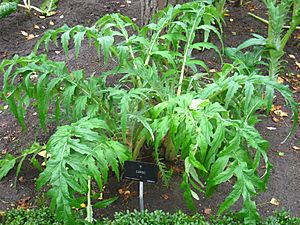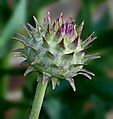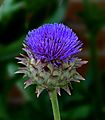Cardoon facts for kids
Quick facts for kids Cardoon |
|
|---|---|
 |
|
| Plants in bloom, Sudoeste Alentejano e Costa Vicentina Natural Park, Portugal | |
| Scientific classification |
The cardoon, also known as the artichoke thistle, is a plant that looks a lot like a thistle. It belongs to the Asteraceae family, which includes sunflowers and daisies. The cardoon grows naturally in the western and central Mediterranean region. People have grown it for food there since ancient times. You can still find it growing wild in those areas today.
Contents
What is a Cardoon?
The wild cardoon is a strong, perennial plant, meaning it lives for more than two years. It can grow from about 2.5 to 5 feet (0.8 to 1.5 meters) tall. Its leaves are deeply cut and have many spines. They are green to grey-green and can be up to 20 inches (50 cm) long. The spines can be up to 1.4 inches (3.5 cm) long.
The flowers are violet-purple and grow in a large, round, spiny head up to 2.4 inches (6 cm) wide.
Where Cardoons Grow
Cardoons are good at growing in dry places. They are native to the Mediterranean Basin, from countries like Morocco and Portugal all the way to Libya and Greece. They also grow in places like Croatia and Southern France.
Sometimes, cardoons can spread to new areas and become an invasive weed. This means they grow too much and can harm local plants. They are considered a weed in places like Argentina, Australia, and California.
Growing Cardoons
There are two main types of cultivated cardoons:
- The regular cardoon, grown for its edible leaf stems.
- The artichoke, which is grown for its large, edible flower buds.
These cultivated types are different from wild cardoons. They are usually taller (up to 6.5 feet or 2 meters), have fewer spines, and have thicker leaf stems and bigger flowers. These features were chosen by people over time to make the plants easier to harvest and to get more food from them. Wild and cultivated cardoons are very similar genetically. They can easily produce hybrids with each other.
History of Cardoon Cultivation
One of the earliest descriptions of the cardoon might be from a Greek writer named Theophrastus in the 4th century BC. Cardoons were popular in ancient Greek, Roman, and Persian cooking. They remained popular in Europe through the Middle Ages and early modern times.
Cardoons also became common in gardens in colonial America. However, they became less popular in the late 1800s and are not very common today.
Modern Cultivation
In Europe, cardoons are still grown in France, Spain, and Italy. In the Geneva region of Switzerland, a special type called Argenté de Genève is a local food. To make the stalks ready to eat, farmers often tie them together and wrap them in straw for about three weeks. This process is called blanching. It makes the stalks white and tender. Cardoons are also common vegetables in North Africa, often used in dishes like couscous.
Cardoon stalks can have tiny, almost invisible spines that can be painful if they get into your skin. To solve this, farmers have developed types of cardoons that do not have spines.
Cardoons need a long, cool growing season, about five months. They also need a lot of space to grow. Because of this, they are mostly grown in places where they are already popular. In the United Kingdom, the cardoon has received the Royal Horticultural Society's Award of Garden Merit. This award is given to plants that grow well in gardens.
Cardoons as Food
Nutrition
Raw cardoon is mostly water (94%). It has some carbohydrates (4%) and a small amount of protein (1%). It has almost no fat. A 100-gram serving of cardoon has only 17 calories. It also provides good amounts of folate, magnesium, manganese, and sodium.
Culinary Uses
While the flower buds can be eaten like small artichokes, people usually eat the stems. The stems are often braised (cooked slowly in liquid). Cardoon stems are a part of Lyonnaise cuisine in France, for example, in a dish called gratin de cardons.
To make the inner stalks edible, they are often protected from sunlight for several weeks. This was traditionally done by burying the plant underground. Today, farmers usually wrap the plant in black plastic or other dark material.
The flower buds of wild cardoons are still gathered and eaten in southern Italy and Sicily. In Spain and Portugal, the flower buds are also used to make cheese. The flower parts are used as a vegetable rennet to help the milk curdle. This is how cheeses like Torta del Casar and Queijo de Nisa are made.
Cardoon leaf stalks look like giant celery stalks. They can be served steamed or braised. They taste a bit like artichoke, with a slight bitterness. They are harvested in winter and spring, and are best just before the plant flowers. In the Abruzzo region of Italy, a traditional Christmas lunch often starts with a soup made from cardoon cooked in chicken broth with small meatballs.
In Spain, cardoon stalks are a special food, especially in the northern regions of Navarre and Aragon. There, they are grown in large amounts. In Spain, cardoons are usually boiled to soften them. Then, simple sauces like almond sauce or small amounts of jamón (cured ham) are added. Sometimes, they are combined with clams, artichokes, or beans.
Because they are available from November to February, cardoons are a main part of Christmas dinner in Navarre. For this reason, cardoons are often sold preserved in water or brine, so people can eat them all year. Cardoons are also an ingredient in cocido madrileño, a traditional Spanish stew.
In the US, cardoons are not often found in regular grocery stores. However, you might find them in supermarkets that serve Italian and European communities. They are also available at some farmers' markets in late autumn, around Thanksgiving and Christmas. The main root of the cardoon can also be boiled and served cold. In New Orleans, the stems are traditionally battered and fried for St. Joseph's altars.
Wild cardoons can be found near streams, rivers, and even ditches in rural areas. These wild plants look different from the ones grown on farms. They have many thin stems with broad leaves. The stems can have a reddish color. To use them, you remove the leafy part and clean the stems of "stringy" fibers.
Cardoon is also one of the herbs used to flavor a type of Italian liqueur called Amaro.
Other Uses for Cardoons
Cardoons are used as a plant-based source of enzymes for making cheese. In Portugal, traditional cheese making often uses only this vegetable rennet to curdle the milk. This is how cheeses like Serra da Estrela and Nisa are made.
The cardoon is also grown as an ornamental plant because it looks impressive in gardens. It has bright silvery-grey leaves and large flowers.
Scientists are also looking at cardoon as a possible source for biodiesel fuel. The oil from cardoon seeds, called artichoke oil, is similar to safflower and sunflower oil. Cardoon is being used in the world's first biorefinery in Porto Torres, Sardinia. This plant converts cardoon into materials for making bioplastics.
Images for kids
-
Cultivated cardoons in Ágreda, Spain
See also
 In Spanish: Cardo comestible para niños
In Spanish: Cardo comestible para niños














